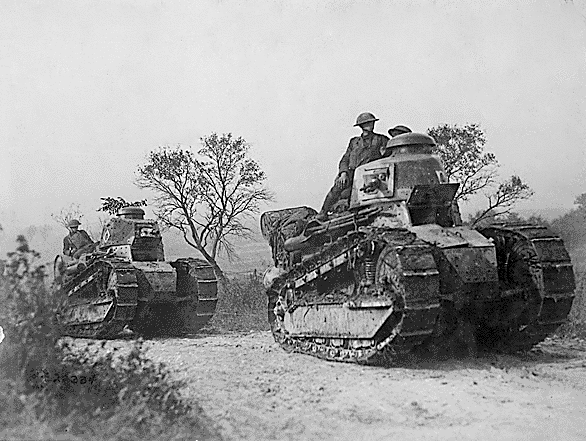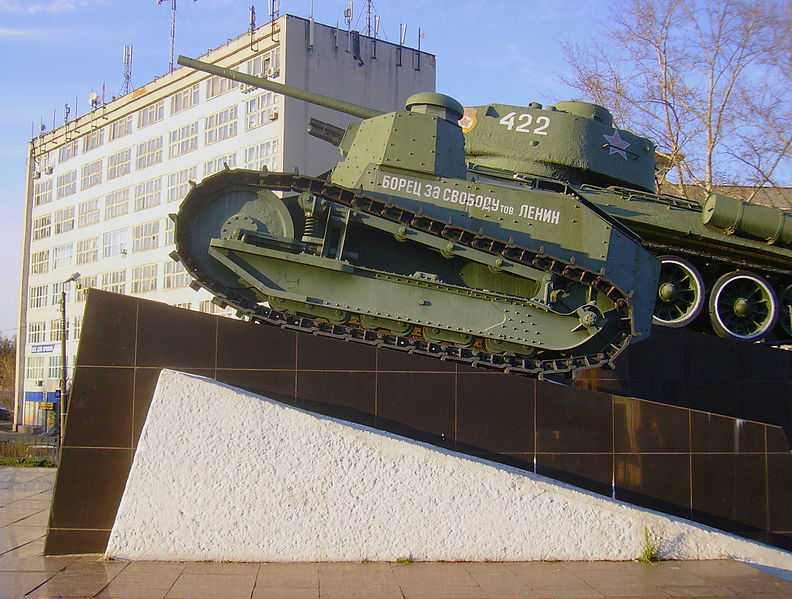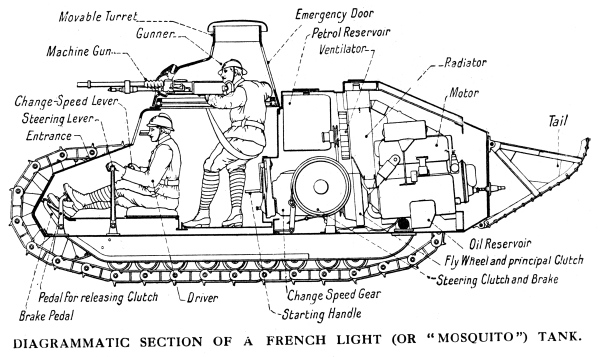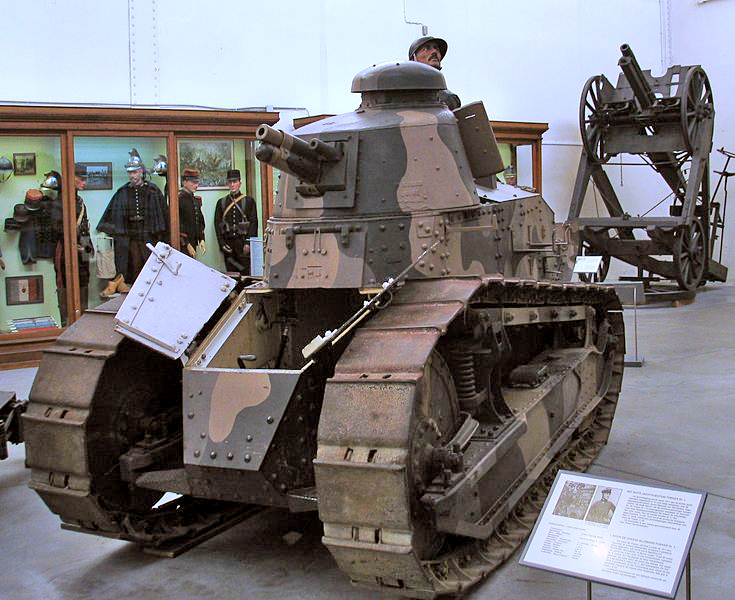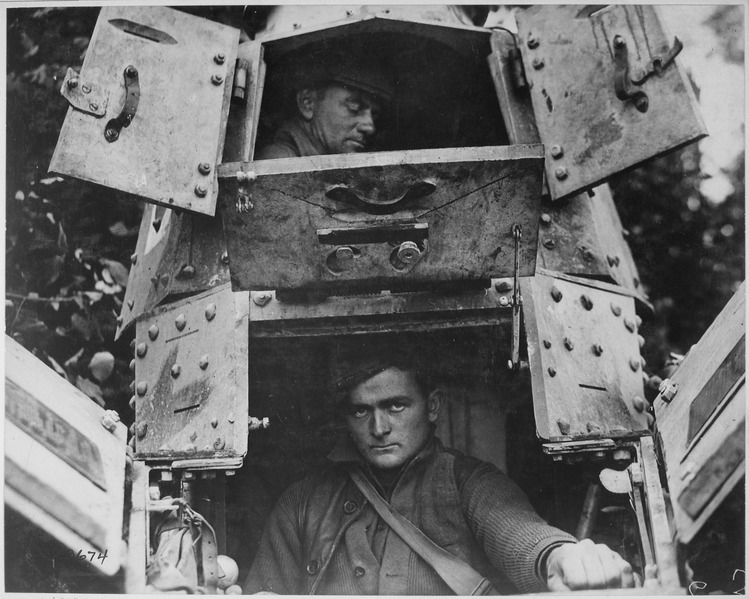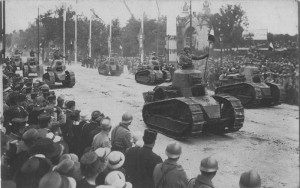The world’s first modern tank
Tank development went on at the same pace in Great Britain and in France in 1915. When “Little Willie” had already passed all its tests, so had the French Schneider CA-1. This machine was first suggested and conceived by Eugene Brillé, chief engineer of Schneider on the Holt tractor chassis and designed by Col. Estienne, the French “father of the tanks”, between May and September 1915. It had to overcome many problems and was first engaged en masse during General Nivelle’s offensive of April 1917 at Berry au Bac. It performed poorly, lacking speed, good maintenance, protection, trench crossing ability and was also very cramped. This painful experience made Estienne and other tank enthusiasts in France to think differently, both tactically and technically, and this ultimately led to the development of the Renault FT, a pioneering vehicle whose basic features are still found on modern MBTs.
The idea and concept
The Renault FT was also called “FT 17” although this specific naming was never acknowledged by Renault or any official working on the project. It was to be related to the year 1917, like “modele 1917” as it was customary for many French weapons of the time, but this was introduced after the war. “FT” has no meaning but was the next identification letters available for this project in Renault nomenclature (some authors suggested later “Faible Tonnage” “low tonnage” or “Franchisseur de Tranchées” “trench crosser”). It began as a concept, and became a personal project of Louis Renault, the famous car maker. He sought the ideal weight-to-ratio proportion for a more agile and faster tank than the Schneider CA-1 and the heavy Saint Chamond, and also a cheaper and easier model to produce. All started after a meeting between Colonel Estienne and him at the Hotel Claridge in Paris. Until then, Louis Renault declined any involvement into tank production, claiming his lack of experience with tracked vehicles and other commitments. However, as an engineer he was taken up by the challenge, and after the meeting, started a practical study for a light vehicle, easy to manufacture with a reduced, unskilled workforce (factories had been depleted then by mass drafts and enlisting).
The core idea came from Estienne himself. Instead of cumbersome armored boxes, he imagined an immense fleet of cheap “bees”, five or six light tanks for the price of a single St Chamond. Small, fast and narrow, they could, by their sheer number, overwhelm the enemy defense -hence the “swarm of light tank” concept. Knowing the administrative and industrial roadblocks before him, he approached one of the most prominent French industrialists of the time. He also imagined a tank with a power-to-weight ratio good enough to overcome trenches and shell craters, and a fully rotating turret to take full advantage of a single weapon, either a gun or machine-gun. The fully rotating turret was not new. It was used operationally since 1915 on many French armored-cars, Renault, Peugeot and White, and by countless others around the world. The 1905 Charron armored car already used fully revolving turrets.
Development history
The light tank concept was not one that felt natural to military strategists, despite the fact that it was easier to produce en masse. This was the gamble of Louis Renault, whom, with the unwavering support of Col. Estienne, directly called for the acceptance of his ideas from the commander in chief, Joffre, but he was then rebuffed by the minister of the armaments and production, Albert Thomas. The latter only agreed for a single prototype. More so, when production got approved in December 1916, confirmed again in February 1917, the order was postponed due to priority being given to artillery tractors instead.
It was officially accepted in May 1917, when Pétain replaced Nivelle, but, still, the reluctant director of Motor Services, general Mourret, was not replaced before September by Louis Loucheur, who finally gave the green light. In the meantime, the prototype delivered in January 1917 performed first trials at Renault’s Billancourt factory, before being sent to the Artillerie spéciale proving grounds at Champlieu for corrections. Although performing according to plans, it was later met with skepticism by the commission officers present at Marly on 22 April. Some asked for better ventilation, a wider turret and hull, or to raise the ammunition capacity to a staggering 10,000 cartridges! Still, the project had the enthusiastic support of the Consultative Committee of the assault artillery, and General Pétain’s arrival on the scene seemed to unlock the situation. He was sold on Estienne’s ideas, but for different reasons: He saw these as a morale-booster for simple soldiers. Helater ordered that all the trucks carrying these tanks to the frontline had this mention written in large characters on their back plate: “Le meilleur ami de l’infanterie” (“infantry’s best friend”).
Design
The Renault FT prototype included a rotating turret, a concept already tested with the Little Willie, a rear engine configuration, a front driver, with the turret operator (and commander) right behind. Compared to the short and narrow hull, the modified Holt chassis was big enough to allow sufficient grip on any ground. To manage large trench crossings a rear tail was mounted, which facilitates balance and hanging. Instead of “mobile fortresses” or “land cruisers”, the Renaut FT seemed lightly armed, but the turret made it versatile and efficient in most circumstances.
Renault’s talented engineer Rodolphe Ernst-Metzmaier designed a narrow riveted box (slightly more than an average shoulders width), with flat sides, pointed noise and sloped rear. All available internal space was used, with almost no room to spare. The engine was located at the rear, and separated from the fighting compartment by a firewall. The driver sat on the front, his feet acting on the brake and release clutch pedals between the large pair of idler wheels. The commander stood just behind him. At first the standing position was only meant for short-term offensive, but with time, a leather strap was fixed on both sides, as an improvised sitting. However, the commander still had to stand up to use his narrow cupola.
The crew accessed the tank through the front, through a two-doors hatch, and collapsible upper vision armored panel. The commander could exit from the rear turret hatch, a feature which became mainstream on French tanks. The driver had three vision slits, one on the collapsible panel, two on the sides.
The Renault 4-cylinder air-cooled petrol engine was started either by a rear crank or an internal one. It was handily reachable from above, protected by a large hood. The petrol tank was installed after the turret and before the engine, high for gravity and well-protected except from above.
A steel chain was usually suspended on the rear tail in order to be used for towing another vehicle. Large metal boxes were suspended on the flanks, with shovels, picks, spanner and other tools, as well as sometimes additional fuel tanks and spare track links. There was no means of communication between the turret operator and driver and the interior was almost deafeningly noisy, so a kind of “kicking code” in the back, shoulders or even head of the driver was used to transmit steering orders. These were armed with a Puteaux SA 18 37 mm (1.45 in) short-barreled, low-velocity gun, or a coaxial Hotchkiss 7.92 mm (0.31 in) machine gun.
Production (1917-18)
The prototype was examined by a commission, but almost cancelled in favor of the new Char 2C heavy tank, which never made its appearance before the armistice. After a few mass-production modifications on the prototype, the first wave was ordered in December 1916 for deliveries in February 1917, but amended, then suspended, and was still in jeopardy in May, despite the arrival of Pétain. It was not until September 12 that the new armament minister Louis Loucheur took Thomas’s office, and the project was definitely approved. Under Charles-Edmond Serre’s supervision, the first 84 machines were delivered prior to the end of 1917, and 2697 more until November 1918. This was, by far, the largest tank production by any country at that time, but caused problems to Renault which was still not ready to fulfill such orders and convinced other firms to share the lot, like Berliet at Lyon, and (Schneider) Somua and Delaunay Belleville. It was proposed as a licence to foreign countries as well, and the US industry was first in line, the federal government receiving a single tank and complete plans for 1200 more, both to cover the needs of the French and US Army.
Renault produced two variants of the FT, the “female”, or machine-gun model, which was more common, and the “male”, armed with a short-barreled 37 mm (1.45 in) Puteaux SA 18 gun. Those models also differed by their definitive “Omnibus” turret, multi-faceted (standard) or rounded with bent metal plates, also known as the “Girod turret” first introduced by Berliet (hence the “Berliet turret”). By December 1917 3100 FTs were to be produced with the Omnibus turret, in both types, as well as 700 derived BS versions (fitted with a short 75 mm howitzer) and 200 TSF, radio versions. In January 1918, the order was again shifted for 1000 “female”, 1850 “male”, 970 BS (howitzer versions) and 200 TSF. In October the total order has reached a staggering 7820 machines. In November the armistice came and the order was cancelled, 1850 had been delivered so far by Renault, 800 by Berliet, 600 by Somua, and 280 by Delaunay-Belleville. The largest turret manufacturer was Paul Girod Aciéries at Ugine, which casted, assembled and forged round and octagonal models.
Problems were experienced with the armor plates. Many came at the time from Britain, which caused delays due to local priorities. The supply of the new 37 mm Puteaux gun, specially redesigned from a light artillery gun, was also slow to reach full production. Despite the considerable delays (almost a year) before an effective production started, the first batch was still plagued with defects. About one third of the initial order had to be shipped back to the manufacturer for corrections. There was also a continuous lack of spare parts, which hampered the units’ operational capabilities and limited maintenance in the field. The poor quality of the fuel filters in particular, and the highly sensitive fan belts caused considerable turmoil and up to ten per cent of active vehicles were unfit for service in 1918 because of this, waiting for replacement parts.
In 1919 a new redesigned version was proposed by Renault, including a more powerful engine, a long-barreled Puteaux gun and additional cases fitted in their tracks. It was successfully exported throughout the world. Some of them were immediately put into action, like the Finnish and Polish versions against the Soviets.
War operations of the FT
The small FT was an undeniable success, despite some flaws of the first series, including the radiator fan belt and cooling system problems. Large number of FTs were provided to most Western front units by mid-1918, and they were involved in all major offensives (4356 engagements and 746 lost in action), successfully crossing no man’s land and “cleaning” trenches as designed, but also forests.
The first operational unit using FTs was the 1st BCL (Batallion de Chars Légers), on 18 February 1918. But only at the end March did this unit receive its full tank complement, although still unarmed. Each battalion counted three companies, with a full strength of 75 vehicles. The majority were MG-armed (41), with 30 gun-armed and up to four TSF, with 3 vehicles in reserve.
Although it was smaller and less impressive than previous tanks, the FT was nevertheless successful, as Estienne had predicted, because so many reached the enemy lines at the same time, overwhelming the German defenses. It was also a tricky target due to its narrow section and small height. It gave confidence to the regular soldiers whom advanced behind it, avoiding most of the punishing machine-gun fire. First engagement occurred in May, 1918 at Foret de Retz, near Soissons. Tactics also involved a combination of gun-equipped “male” tanks to strike machine gun nests and pillboxes, and “females”, equipped with a 7.92 mm (0.32 in) Hotchkiss machine gun to finish the job. There, the rotating turret made all the difference. As the production rose and the tactics were refined and codified, a swarm of light tanks was intended to be thrown towards the German lines in the greatest Allied offensive planned for January-February 1919. Of course the armistice put an end to this plan, including a grand total of 12,260 tanks to be built in France, USA, Italy and Great Britain.
The American FT
Soon after the US joined the war, it was considered suitable to equip the newly formed units with provisional French FT tanks. Since the French general staff needed a huge production, US manufacturers were approached. Built under licence and with a revised design, this was later called “6 tons tank M1917” for “model 1917”. In fact, an estimated 514 FTs were delivered and 950 M1917 were built under licence (accepted in October 1918), but none were put to action before the end of the war. Later on, in mid-1919, a revised version was produced, the lengthened M1917A1, with minor alterations and a new, more powerful 100 hp (74.6 kW) Franklin petrol engine and an electric starter. Production was assumed by Van Dorn Iron Works, the Maxwell Motor Company, and the C.L. Best Tractor Company. The M1917 formed the basis of the future US Army corp of the early twenties.
A world success
If the United States, which were involved in the war, logically received many FT 17s, other countries also did. The Italians, for example, received 3 which were later copied and modified to produce the FIAT 3000. 24 were also used by the British, for testing. The French alone accepted in active duty during and after the war no less than 3177 machines, which made the French army, by far, the dominant tank force in the world at the time, and remained so nearly twenty years after. Exports, well served by Renault’s knowledge of the international market, reached Poland, Finland, Estonia, Lithuania, Romania, Yugoslavia, Czechoslovakia, Switzerland, Belgium, Netherlands, Spain, Brazil, Turkey, Iran, Afghanistan and Japan. These tanks remained in first line many years in these countries, to the point that two Afghan FT17s were found in relative good condition during “Operation Enduring Freedom”! Actually the US still has many M1917s as museum pieces, but none of the original French FT. The only one, previously owned by the Patton Museum of Cavalry and Armor, was turned to the French government at a French request.
Variants
In fact the gun armed variant was sometimes incorrectly dubbed FT 18. Among variants were 188 radio carrying vehicles (Renault TSF), about 40 FT 75 BS, armed with a punishing 75 mm (2.95 in) howitzer to deal with concrete pillboxes, the 13 Japanese modified FT-Ko, the 27 FT CWS built in Poland with French spare parts (also one gas firing model) and about 1580 FT 31, upgraded models with the new Reibel 7.5 mm (0.3 in) machine gun. These were still in use in regional units in September 1939, and many of them were posted outside the metropolis. The “Russkyi Reno” remains unique, but a modified version with a new sprung suspension was built in large numbers during the early twenties. During the interwar period, these Renault FT fought in many events, like the Russian Civil War, the Polish-Soviet War, the Manchurian War, the Chinese Revolution, the Rif War (in Morocco), the Spanish Civil War and the Estonian war.
Other French variants include anti-tank gun FTs, which would have been armed with a 25 mm (0.98 in) or a 40 mm (1.57 in) gun. Some 2,000 FTs, then in service and in reserve, were planned for conversion. An FT with an experimental short-pitch track was designed in an attempt to increase speed, but the Kegresse system was preferred. Several SPGs were considered, the 75 Chenilles and 105 L Chenilles, which featured the gun aimed at the rear of the vehicle. The STAV Chenilles and STA 75 Chenilles also competed for the SPG requirement. A Renault FT Ammunition Carrier was planned to aid these SPGs.
The FT 75 BS Poseur de Pont was planned to mount a bridge for other FTs to cross, but it was cancelled. A handful of Renault FTs were planned to mount a mast with two floodlights, planned to aid with lighting the trenches and policing duties. FTs were also planned to mount fascines, a snowblower, a bulldozer, and a crane. The Renault FT featured the first ever mine plow, but it was never mass produced. Some FTs were planned to be converted to agricultural tractors, but several problems cancelled the project. An odd plan was the FT Poseur de Masque, which carried a 2-ton concrete block that was intended to obscure machine-gun slits on the Siegfried Line.
Camouflage
After some successful experiments with field artillery, French tanks were painted in sophisticated patterns comprising between three and seven different colors, sometimes separated by black strips, known as “tiger pattern”. There were not intended to blend the vehicle into the background but to disrupt the shapes for enemy observers. Professional artists, led by Guirand de Scevola, a cubist academic painter, were committed to study visual disruption and apply often complicated patterns, later summarized as the “dazzle”. But with the growing production, these patterns were simplified to be applied by unskilled workers right at the factory.
Interwar & World War Two
FT 17s after the war were in service with more than 20 countries around the world and took an active part in many military conflicts on different continents. It has become one of the most popular interwar model, and purchased by Finland, Estonia, Lithuania, Yugoslavia, Belgium, while Czechoslovakia, Switzerland, the Netherlands, Greece and Sweden tested it. The biggest buyer outside Europe was Brazil. The FT influence worldwide could not be underestimated: They were the very first US, Soviet and Italians tanks, generating close-copies and printing a profound mark on later developments.
There were still thousands of FTs in various conditions around the globe when the Second World War broke out. The bulk of this WWI vintage fleet was in France, mostly because of a late rearmament. Both the Renault R35 and Hotchkiss H35 were due to completely replace this model (almost 2800 light tanks combined in May 1940). But still around 1850 FTs were listed as of 1939, renamed “FT-31”. These were rearmed version with the Reibel 7.5 mm (0.295 in) compact machine-gun, a gas-operated model originally designed to serve on the Maginot line. But this upgrade did not improve their limited capabilities in range and speed, although not worrying an ageing general staff still thinking in trench warfare terms. Many were stationed in the Colonies, others served in second line, some were in various depots or assigned to training units when the western campaign began. This fleet was seized by the Germans, and reused for various duties.
Numerous Renault FT-17s saw action during the three first years of the war. The Polish ones were committed when the Germans launched Fall Weiss, Finnish modified Naaras and Koiraas fought as dug out pillboxes for ambushes during the winter campaign, the Belgian FT-18s were also at the stakes when the Werhmacht crossed the north-eastern border in May 1940. Later on in April 1941, the Yugoslavian FTs and a very few Greek models also saw action against the Panzerdivisions. In Indo-China, also in 1941, French colonial armored brigades equipped with the FT-17 (in original conditions) opposed a Thai invasion. The very same year, Iran, still operating a small fleet of FTs was found mobilized during the Anglo-Soviet invasion of their country. Perhaps some of these were sold or sent to Afghanistan and found some years ago by G.I.s in a metal dump.
In French service
The FT-31 was a large-scale modernization of all existing FT models, upgraded with a new Reibel 7.5 mm (0.29 in) machine gun and a new mask. About 1560 took part in the battle of France in May-June 1940. Some were parts of regional airbases defence forces. Most were captured and later served with Vichy forces and the Wehrmacht. Other were still listed in the Colonies of North Africa, Indo-China, and Syria and many survived until 1945.
In German service
After the fall of France, the Wehrmacht captured as many as 1700 FTs, which were redesignated, painted in feldgrau with the Balkenkreuz. They were all machine-gun equipped. All captured FT 31 tanks which were not allocated to the Vichy police forces were taken over by the Wehrmacht. Some served as training machines. Others, often rearmed with a more potent machine gun, served as airfield guarding vehicles, snow ploughs, were deployed in counter-insurgency forces, armored trains and for police duties in all of Europe and fought during the Paris uprising in August, 1944. Official designation was PzKpfw 17R 730(F), 730c being the gun version (rearmed with the 37 mm/1.45 in Puteaux), and 730m the machine-gun version. They were painted in the usual feldgrau scheme, but some later units replaced in active duties in France were painted with dark green stripes.
Poland
The Poles contracted the delivery of 23 FTs for the defense of their newly liberated country. But they never saw action until the very end of the 1920 Soviet-Polish War. Most of those involved in the battle of Warsaw and other events were French FTs which French or Polish crews. Later on, many more were acquired, reaching a maximum of 174 machines. Some were later made by CWS (meaning “Centralne Warsztaty Samochodowe” – Central Car Workshops) which manufactured 26 or 27 tanks from French spare parts between 1925 to 1927, plus some with Polish iron plates and other parts. The local production model used soft iron instead of steel, and were retained for training as the armor was improper to combat usage. Perhaps 30 to 60 Polish FTs were later sold to Uruguay (which in turn sold them to Spain, then in Civil War), others were bought by Yugoslavia and China. Polish engineers devised improvements, like a faster prototype equipped with laterally flexible tracks or designed derivatives like the smoke tank Czolg dymotworczy.
Italy
Italy got three FT-17s in June 1918. But the deliveries were reserved to French units first, so the general staff decided to start their own production. Despite the fact that the program was cancelled in November 1918, the design was drafted for the upcoming FIAT 3000 finally delivered in numbers between 1922-1926.
Spain
12 FTs were bought in August 1921, all machine gun armed, deployed in 1922 in Morocco against Beni Said Tribe (Rif war). These were later found on opposite sides during the Civil War, with the Republicans (the 1st Tank Regiment of Madrid), and on the side of Franco’s nationalists with the 2nd Tank Regiment of Zaragoza. The 1st Regiment took part in the defense of Madrid on September, 1st, 1936. The FT remains influential in the design of the Trubia, the first Spanish tank built in small series between 1926-1931.
Russia
During the Polish-Russian war of 1920 and the Civil war, both the Poles and the White Russians had many FTs enlisted, later captured by the Red Army, notably at the battle of Berezovka. By 1920 the Red Sormovo factory succeeded in copying this model and produce the first Soviet tank (“Freedom Fighter Comrade Lenin”), now preserved, followed by a series of “Russkiy Reno”, which had a long barreled 37 mm gun and a machine-gun in a separate turret mount. Ultimately this experience led to the development of the T-18, largely influenced by the FT design.
Finland
There were about 32 tanks given to the Finnish army in 1919 and two more provided in 1920, all equipped with the 1919 model rounded turret and long barrel 37 mm (1.45 in) Puteaux gun. Most of them were still in use during the Winter War of 1939. Some were placed in entrenchments, others used as training tanks and were still in service in 1943. Some were called Koiras (14), gun armed, equipped with the long barrel Puteaux 37 mm (1.45 in), or Naaras (18), machine-gun versions.
They first saw action in Russia with General Yudenich’s White Arm. Base livery was med grey, but they later received a camouflage made of green and red brown stripes, with partially washed white paint over it in winter. During the Winter War of 1939 most of them were dug into hull down positions and used as pillboxes in defensive lines or pre-positioned ambushes. Others served as training machines until 1943.
Yugoslavia
The Royal Army of Yugoslavia acquired 34 FT-17s in the early twenties (54 according to sources claiming 8 being from French units left in Bulgaria, the others in the 1930s, including some Polish-made CWS), followed by 21 Renault NC2 (M26/27) Kégresse, improved, faster models. The batch was completed later by 54 Renault R35s. All were committed against the German onslaught in April 1941.
Brazil
Total order in 1921 was 12 “carros de assalto”, enough to make a company with 4 machine gun armed, 7 gun-armed, and one TSF, command version. A former WWI observer in French units and father of the Brazilian tank force, Captain José Pessôa Cavalcanti de Albuquerque, suggested the purchase. Although they were initially purchased to test tactical theories, these tanks fought against the rebellion of 1924 and the revolution of 1932, and survived WWII, being kept for training purposes.
Belgium
The Belgian army purchased some 75 gun-armed versions, slightly modified and locally called FT-18. The engine was modified, giving an extra kph in top speed, and the armor was slightly reinforced. All were still in service by May 1940.
Lithuania
Twelve Renault FT-17 tanks were bought from France in 1923. The tanks were named “Audra”, Drasutis”, “Galiunas”, “Giltine”, “Grianstinus”, “Karzygis”, “Kerstas”, “Kovas”, “Pagieza”, “Pykoulis”, “Slibinas” and “Smugis”. They were equipped with a Vickers machine-gun and served with the Radviliskis tank regiment from the early twenties to the late thirties.
Greece & Turkey
Greece tested both the FT gun-armed and MG-armed and the more modern NC2, but none was ordered. A single batch was delivered to the Turkish Infantry Shooting School based at Maltepe in 1926.
Romania
Although a handful Berliet-built FTs were sent to Romania for training in 1917, some 72 brand-new ones were purchased and delivered in June 1919, to face-off the ever present Soviet threat. They saw widespread service but were withdrawn from active duty and kept for training from 1939.
China
Some 30 to 45 steel Polish-built CWS tanks were sold to China, according to some sources. But the first were former French FTs left in Vladivostock in 1919 (then into “white” Russian hands) were acquired by the Manchurian warlord Chang Tso-Lin. 14 more were acquired in 1924-25 and fought against Wu Peifu. By 1929, all these FTs of various origins were passed onto Chang Kai-Tchek NRA in 1929, as the 1st Cavalry Brigade (perhaps 34 in all). They fought borders wars with the Soviets and later the Japanese. They were joined by British Vickers models. Many were seized in 1931 by the Japanese in Mandchuria. In 1938 or 1939, French FTs from the China Light Tank Company were captured and send to reinforce the puppet army of Manchuko.
Japan
Japan bought the Renault FT in 1919, at the same time with a batch of Mark A Whippets. It was designated “Ko Gata” (Model A). The “Type 79” according to the chronological nomenclature, was never officialized. These thirteen tanks were immediately sent to the newly created Army Infantry School and the first unit, 1st IJA tank Company at Kurume, for officer training. Some were transferred to the Army Cavalry School. In 1929, Japan also acquired the modernized NC-1 (M26/27), Otsu(“B”)-Gata Sensha>. The “Ko-Gata” was used during the incident of Harbin, Manchuria in 1932. The unit was commanded by Captain Hyakutake. Both models were still in active service by 1940. Japan acquired spare parts after the occupation of Vichy-controlled Indochina.
Main source: “The Renault FT Light Tank“, Steven J. Zaloga, Osprey Vanguard 1988.
Another reference: “Minitracks n°10 about the FT“.
Links about the Renault FT
GBM, Histoire & Collection, about ww2 French tanks
The Renault FT on Wikipedia
A French page about the FT17
Wikipedia page about the US 6-ton M1917
Shadocks pdf document about surviving M1917
Operation Priority, a guide on the Renault FT and its variants
Renault FT specifications |
|
| Dimensions | 4.95(with tail)/4.20 x 1.74 x 2.14 m (16.24/13.77×5.7×7.02 ft) |
| Total weight, battle ready | 6.7 tons |
| Crew | 2 (commander/gunner, driver) |
| Propulsion | Renault 4 cyl petrol, 39 hp (24 kW) |
| Speed | 7 km/h (4.3 mph) |
| Range/consumption | 65 km (40.38 mi) |
| Armament | Female: Hotchkiss 7.9 mm (0.32 in) machine gun Male: Puteaux SA 18 37 mm (1.45 in) gun |
| Armor | 22 mm (0.87 in) |
| Total production | 3,700 (France) |
First World War
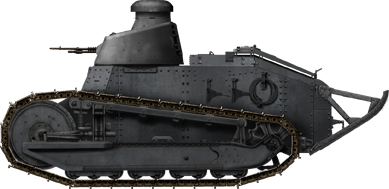
First series, training machines, with the provisional cast turret. The factory grey livery was related to artillery units.
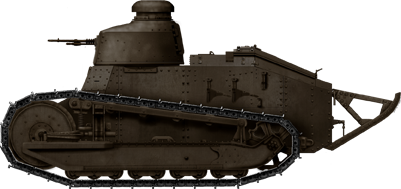
FT early production version with the Berliet rounded turret, and factory dark olive green. The first cast turrets, complex and costly to manufacture, were later replaced by a new model, the “Omnibus” made of riveted plates, either octagonal or rounded.
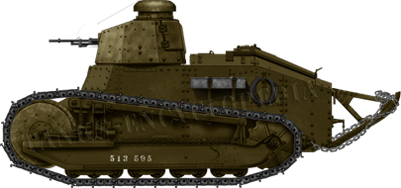
The standard FT of 1917, equipped with a 7.92 mm (0.32 in) Hotchkiss machine gun. About two thirds of all FTs produced during the war were “females” like it.
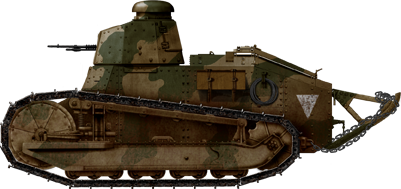
Unknown unit, with the octagonal variant of the “Omnibus turret” developed by Berliet, which was probably the cheapest to produce.
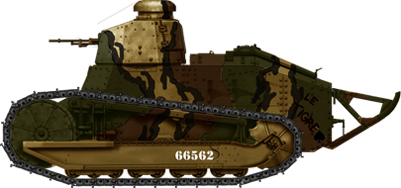
Unknown unit, chassis 66562 “Le Tigre”, tiger pattern, 1918.
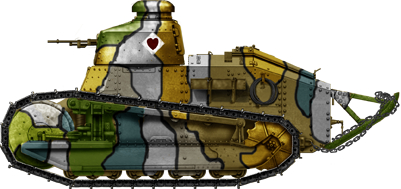
Fall 1918 or 1919, five-tone pattern, later named the “Japanese style”.
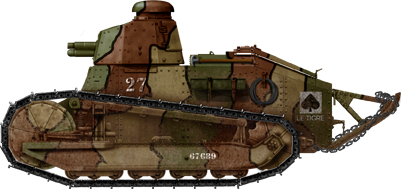
Unknown unit, “Le Tigre”, fall 1917. “The Tiger” was the nickname of the popular French president, Georges Clémenceau.
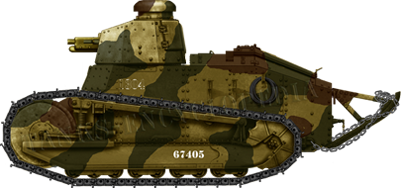
Unknown unit, early 1918, three tone camouflage, applied on the original factory khaki.
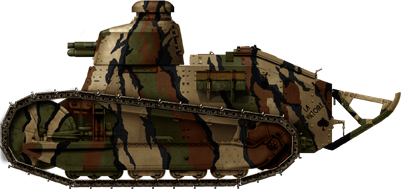
FT Char Canon “La Victoire”, unknown unit, 1918.
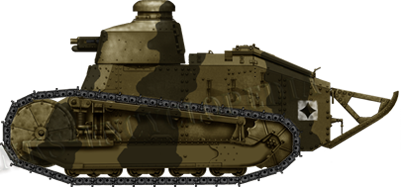
The male Renault FT, armed with a short barrel SA 19 Puteaux 37 mm (1.45 in) gun, with about 238 rounds, used against fortified positions. At point-blank range, a 37 mm shot could penetrate any kind of concrete pillboxes.
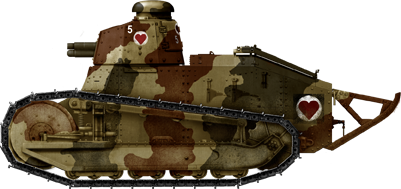
“Char canon”, unknown unit, 1918. The bordering black stripes were often omitted by then.
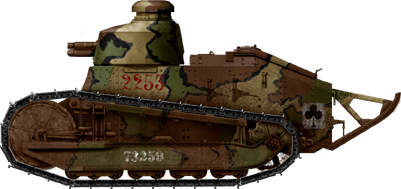
Renault FT, Berliet model with the Girod turret, 506E RAS, 1918.
Variants & Prototypes
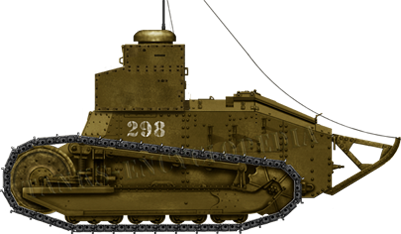
Renault TSF, in khaki livery, early 1918. Click to see another variants.
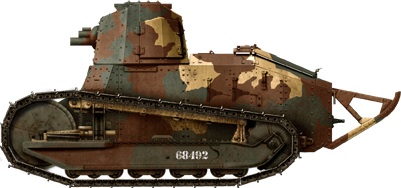
FT 75 BS, howitzer armed version. About 40 were built after the end of the war. Here is an example (unknown unit) with a three-tone 1918 factory-applied camouflage (without bordering stripes).
Interwar
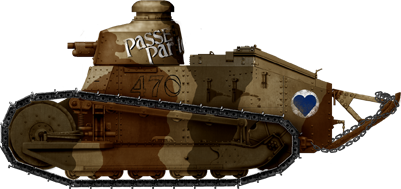
FT “Passe-partout” from the 1st Company, 2nd Section, 2nd Battalion, 1st Polish Tank Regiment, Lodz, 1920.
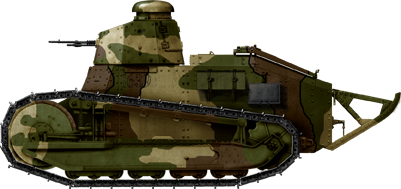
Polish Renault “Lis” from the 1st Tank Regiment, Puk Czolgow.
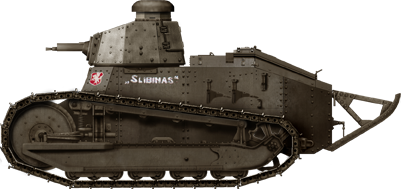
Lithuanian FT(mod) “Slibinas”, 3rd Company, Lithuanian Tank Battalion, Radviliskis 1925.
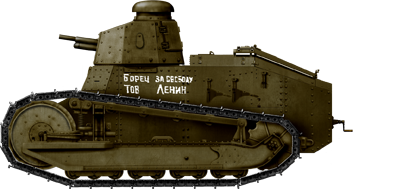
“Freedom Fighter Comrade Lenin” the first Soviet built tank, copied after captured FTs, 1920.
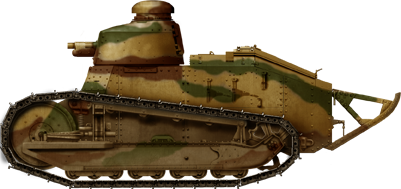
FT-17, 112nd slow-running Tank battalion, Briest 1935
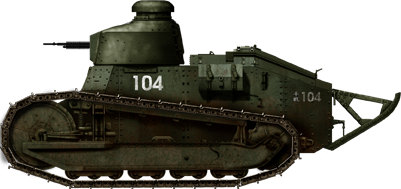
Type 79 Ko-Gata, Manchuria 1937.
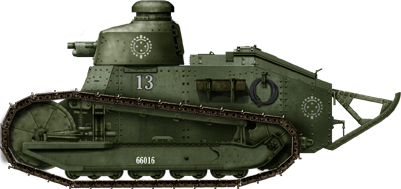
Carro de Assalto, Brazilian FT, 1935.
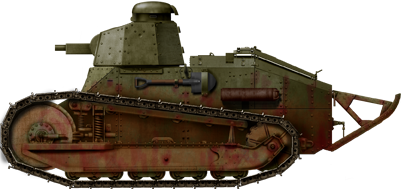
6-Ton tank M1917, armed with the Marlin machine gun, garrisoned for training at Fort Knox in 1920-1925.
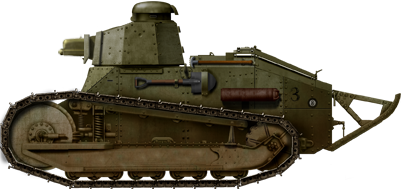
6-Ton Tank M1917, 37 mm (1.46 in) gun version, from the USMC light tank platoon, East Coast expeditionary force, Tientsin, China, 1927.
World War Two
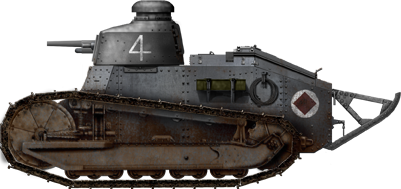
Finnish Renault FT, “Koiras” (gun version) in the original med-grey livery. Click the image to see the Naaras.
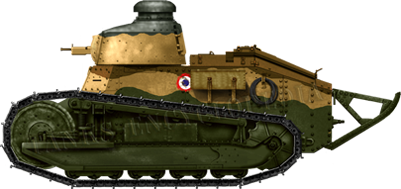
Renault FT modifié 31 (sometimes “FT 31”), modernized version, from the 31st BCC.
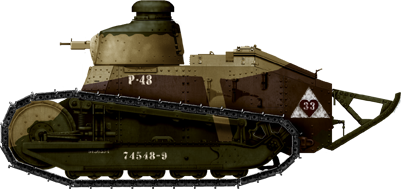
Renault FT 31, 33rd BCC, France, May 1940.

FT 31, 63rd BCC, Aleppo, Syria, 1940.
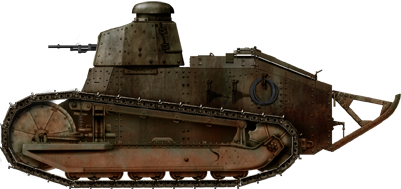
1st Armored Tank Batallion of the Yugoslavian Royal Army, April 1941.
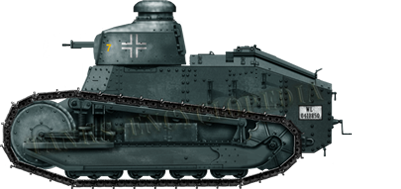
PanzerKampfwagen 17R 730(F), from a driver’s training unit in France, 1943.
_winter44.png)
PanzerKampfwagen 730(F), France, winter 1944.
Gallery

The Great War
 Austria-Hungary
Austria-Hungary Belgium
Belgium British Empire
British Empire France
France German Empire
German Empire Italy
Italy Russia
Russia USA
USAWW1 tanks posters


